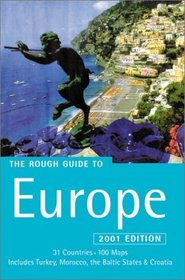Search -
The Rough Guide to Europe 2001, 7th Edition (Europe (Rough Guides))
The Rough Guide to Europe 2001 7th Edition - Europe Rough Guides
Author:
INTRODUCTION The collapse of the division between eastern and western Europe at the end of the 1980s, and the ever closer ties among the fifteen countries of the European Union – increasingly a political and cultural as well as economic union – made Europe a buzzword in the early 1990s, implying shared values and, despite all the wrangling, a b... more »
Author:
INTRODUCTION The collapse of the division between eastern and western Europe at the end of the 1980s, and the ever closer ties among the fifteen countries of the European Union – increasingly a political and cultural as well as economic union – made Europe a buzzword in the early 1990s, implying shared values and, despite all the wrangling, a b... more »
ISBN-13: 9781858285726
ISBN-10: 1858285720
Publication Date: 11/1/2000
Pages: 1,370
Edition: 7
Rating: ?
ISBN-10: 1858285720
Publication Date: 11/1/2000
Pages: 1,370
Edition: 7
Rating: ?
0 stars, based on 0 rating




